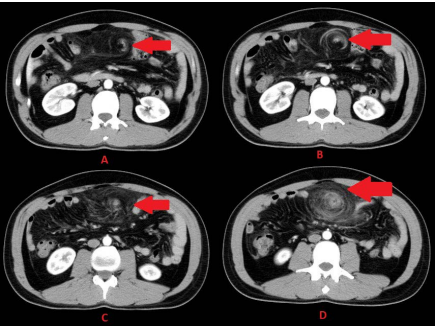Inguinal hernia leading to omental torsion: Role of CT in differentiating from other clinical mimics - a case report and literature review
DOI:
https://doi.org/10.3941/jrcr.v17i11.4722Keywords:
Omental torsion, omental inflammation, acute abdomen, inguinal hernia, CT scanAbstract
Omental torsion is a very rare cause of acute abdomen. Clinically, it mimics other common pathologies such as acute appendicitis, acute diverticulitis and acute cholecystitis. It is therefore no surprise, that it was rarely diagnosed pre operatively before the advent and easy availability of modern imaging techniques. CT scan, in particular, can diagnose omental torsion with confidence pre operatively. This can make conservative treatment possible in cases of primary omental torsion and guide regarding the appropriate treatment in cases of secondary torsion. We present a case of a young male patient who presented to Emergency departments with symptoms of acute abdomen. Clinical and laboratory findings were non-specific for any specific cause of acute abdomen. CT scan, however, showed omental fat stranding with whirlpool sign representing omental torsion which was seen to be secondary to left inguinal hernia. Patient was operated in emergency and necrotic omentum was resected and hernia repaired. Post-operative recovery was uneventful.

Downloads
Published
Issue
Section
License
Copyright (c) 2024 Journal of Radiology Case Reports

This work is licensed under a Creative Commons Attribution-NonCommercial-NoDerivatives 4.0 International License.
The publisher holds the copyright to the published articles and contents. However, the articles in this journal are open-access articles distributed under the terms of the Creative Commons Attribution-NonCommercial-NoDerivs 4.0 License, which permits reproduction and distribution, provided the original work is properly cited. The publisher and author have the right to use the text, images and other multimedia contents from the submitted work for further usage in affiliated programs. Commercial use and derivative works are not permitted, unless explicitly allowed by the publisher.





